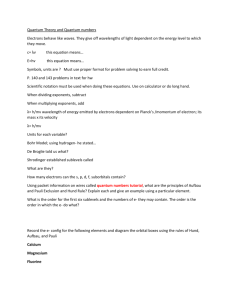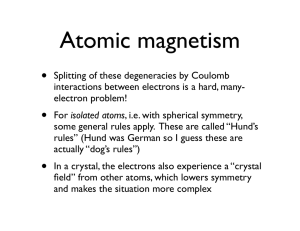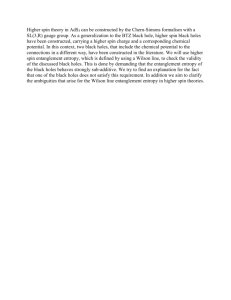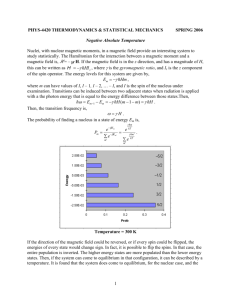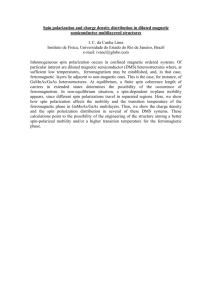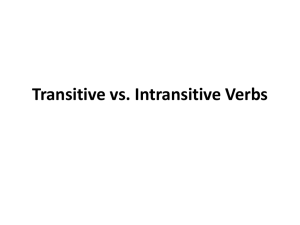(neglecting SOC). • Hund's rule 1: Maximize S • Hund's rule 2
advertisement
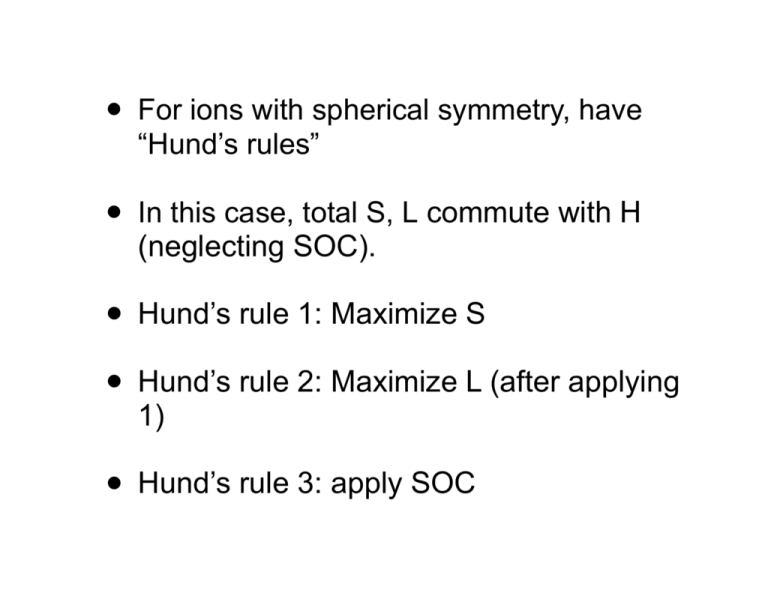
• For ions with spherical symmetry, have “Hund’s rules” • In this case, total S, L commute with H (neglecting SOC). • Hund’s rule 1: Maximize S • Hund’s rule 2: Maximize L (after applying 1) • Hund’s rule 3: apply SOC Hund’s rules • Example: 2 electrons ... 25+2*5*4/2=45 states Hund’s rules • Example: 2 electrons • Rule 1: maximize spin • Forces S=1 • Reason: Pauli exclusion: electrons are kept further apart, which minimizes 1/r Coulomb energy n.b. Sz=1, S=0 OK ... 3*5*4/2=30 states Hund’s rules • Example: 2 electrons • • Rule 1: maximize spin • S=1 Rule 2: maximize L • • n.b. Lz=2, L=3 OK L=3 This is also to minimize Coulomb repulsion but it is less obvious! One picture - but I am not sure it is the right one! - is that electrons orbiting in the same direction are less likely to meet n.b. Sz=1, S=0 OK ... (2S+1)(2L+1) =3*7=21 states Hund 3 • • Hund’s third rule includes the effect of spin-orbit coupling • λ L ⋅ S implies states with different J = L + S have different energy • quantum mechanics: |L-S| ≤ J ≤ L+S Hund 3: • • For a less than half-filled shell, J= |L-S| For a more than half-filled shell, J = L+S This is basically just SOC applied to holes Hund’s rules • Example: 2 electrons • Rule 1: maximize spin • S=1 • Rule 2: maximize L • L=3 • Rule 3: J = |L-S|=2 n.b. Lz=2, L=3 OK n.b. Sz=1, S=0 OK ... 2J+1=5 states 45 → 30 → 21 → 5 states Moments in solids • An ion in a solid is subjected to crystal fields, which lower the symmetry from spherical, and hence split the atomic multiplets • Typically this reduces the orbital angular momentum which is possible • • an extreme case (low symmetry): effectively L=0 because no orbital degeneracy Those crystal fields may be comparable to the atomic Coulomb energies, and hence compete with Hund’s rules 1+2. They are often larger than Hund 3. Local moments • How do we know local moments exist? • Curie Susceptibility • Electron spin resonance • Specific heat (entropy) Curie Susceptibility • Magnetic moment in general is proportional to spin µ = gµB S/~ g-factor (could be a tensor) g ≈ 2 for pure spin moment Bohr magneton e~ µB = = 9.3 ⇥ 10 2me = 0.671K/T • Magnetic dipole interaction H= spin S quantum spin S2=S(S+1) ² µ·H 24 J/T Compare with metals Curie Law Pauli paramagnetism N (gµB )2 S(S + 1) = 3 kT (gµB )2 =V D(✏F ) 4 basically kT → εF Much larger susceptibility than delocalized electrons Magnetic cooling • The large susceptibility of free spins at low temperature means they are easily aligned by small magnetic fields • This alignment corresponds to a drastic reduction of entropy. One can use this control over entropy to remove entropy from another system, thereby cooling it. Magnetic Cooling heat bath Ti heat bath Ti, Hi increase H Ti large entropy Ti, Hf small entropy Tf <Ti lower H Magnetic Cooling • A→ B: isothermal step raise field, lower entropy S A H=H1 H=H2>H1 • B→ C: adiabatic step lower field, same entropy: lower temperature • For paramagnetic spins, S = S(H/T) • Hence H1/Tf=H2/Ti C B Tf Ti T Exchange • How do spins interact? • Magnetostatic dipole-dipole coupling Hd • • d = µ0 0 [3(m · r)(m · r) 3 4 r m · m0 ] This is rather weak, ≲ 1K for even large spins Electrostatic interaction usually dominates, just as it does inside atoms • Indirectly leads to spin coupling through Pauli principle
